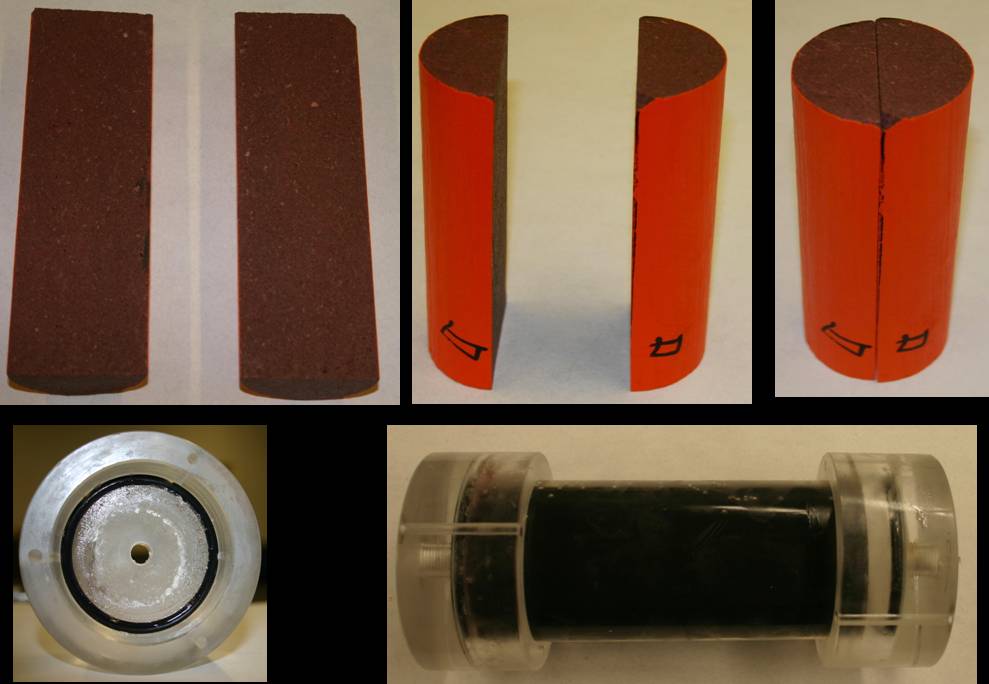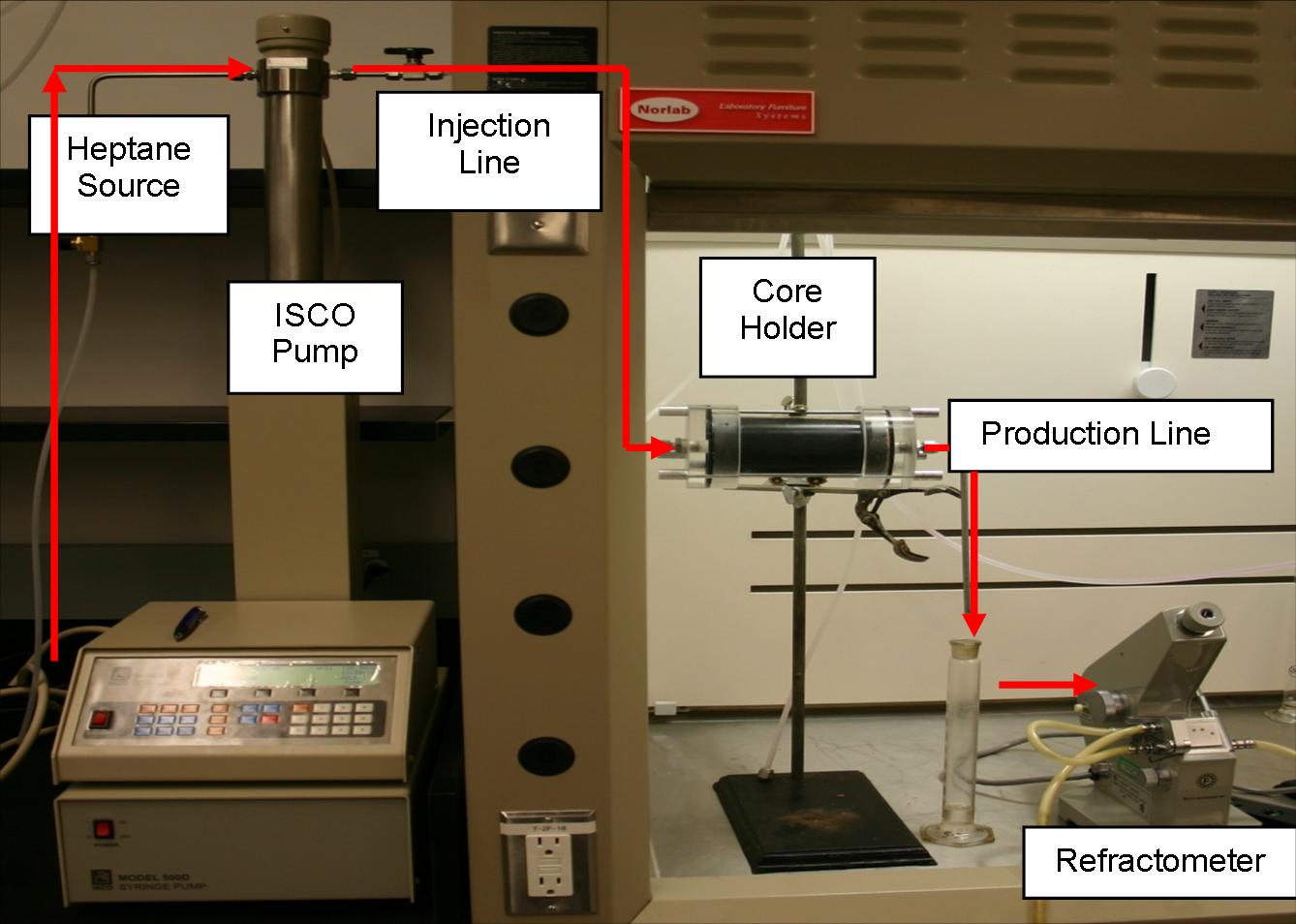


|
Japan Trivedi "Optimization of CO2 Injection for Enhanced Oil Recovery and Sequestration in Naturally Fractured Reservoirs Under Fully Miscible and Near-Miscible Conditions" Japan's research has two aspects: (1) The efficiency of solvent (mainly CO2) injection into fractured reservoirs and (2) CO2 sequestration in fractured/non-fractured oil reservoirs during enhanced oil recovery applications. During the injection of fluids that are miscible with oil for enhanced oil recovery, oil recovery and transport of the injectant are controlled by fracture and matrix properties in naturally fractured reservoirs. For such systems, the transfer between matrix and fracture due to diffusion is the main oil recovery mechanism. Japan's work mainly focuses on generalizing the effects of flow rate, matrix, fracture and fluid properties, to obtain a diffusion driven matrix-fracture transfer function and to propose a critical injection rate for an efficient miscible displacement. 
Artifically fractured samples and core holder used in solvent injection experiments. 
Experimental set-up for heptane injection into fractured rock samples to displace oil (30-40 cp mineral oil) The second part of his research focuses on CO2 (as flue or acid gas form as well as pure CO2) injection into oil reservoirs for oil recovery and sequestration. A large proportion of the world’s proven oil has been found in reservoir rocks that are naturally fractured. Understanding matrix-fracture interaction presents a unique challenge for enhanced oil recovery and greenhouse sequestration in this type of reservoirs. The effects of (a) oil type (mineral oil and kerosene), (b) injection rates, (c) orientation of the core, (d) matrix wettability (changed by aging the cores), (e) core type (a sandstone and a limestone), and (f) amount of water in matrix on the recovery performance and sequestration volume are examined. Cooptimization techniques are applied for maximum oilrecovery and maximum amount of CO2 volume sequestered. The Midale field will be used as the case in this study and CO2 storage capacity during CO2 injection will investigated. A current study also deals with greenhouse gas (acid gas) storage in enhanced oil reocvery applications in the Zama field. Acid gas generation (60-80 % CO2 and 40-20 % H2S) and safe geological disposal, or conversion to elemental sulphur with associated emissions, is an ongoing concern in this field. Acid gas is found to be an effective EOR agent since H2S reduces the minimum miscibility pressure (MMP) of CO2. In large amounts H2S and LPG have been found to decrease the MMP while on other hand methane and nitrogen tend to increase the MMP. These impurities also have some effect on the acid gas solubility in oil and result in changes in formation volume factor and viscosity of oil. Approximately 2.5 Mt. CO2 and 2.0 Mt H2S have been stored in depleted oil/gas reservoirs or deep saline aquifers. Storing H2S with the CO2 in underground reservoirs will double the benefit for the environment in terms of both short (mainly H2S) and long term effects (mainly CO2) to the environment with the opportunity for a possible enhanced oil recovery application. Japan conducts feasibility analysis of this double-benefit process using a compositional numerical simulator. |
- Babadagli, T. and Trivedi, J.: “Evaluation of The Critical Parameters Affecting Co2 Sequestration Performance During Enhanced Oil Recovery,”
Int. Symp. On Earth Science and Tech., Organized by Cooperative Int. Network for Earth Sci. and Tech. and Kyushu Univ., Dec. 1-2, 2008, 7-14.
- Trivedi, J. and Babadagli, T.: “Experimental Analysis of CO2 Sequestration Efficiency during Oil Recovery in Naturally Fractured Reservoirs,”
Energy and Fuels,vol. 23, no 8, 2009, 4025-4036.
- Trivedi, J. and Babadagli, T.: “Experimental and Numerical Modeling of the Mass Transfer between Rock Matrix and Fracture,”
Chem. Eng. Jour. , vol. 146, 2009, 194-204.
- Trivedi, J. and Babadagli, T.: “Efficiency Analysis of Greenhouse Gas Sequestration during Miscible CO2 Injection in Fractured Oil Reservoirs,”
Env. Sci. and Tech., vol. 42, no. 15, 2008, 5473-5479.
- Trivedi, J. and Babadagli, T.: “Scaling Miscible Displacement in Fractured Porous Media Using Dimensionless Groups,,”
J. Petr. Sci. and Eng., vol. 61, 2008, 58-66.
- Trivedi, J., and Babadagli, T.: “Efficiency of Diffusion Controlled Miscible Displacement in Fractured Porous Media,”
Transport in Porous Media, vol. 71, no. 3, Feb. 2008.
- Trivedi, J. and Babadagli, T.: “Optimal Injection Strategies for CO2 and Flue Gas Sequestration During Tertiary Oil Recovery,”
Oil Gas European Magazine, vol. 33, March, 1/2007, 2007, 22-26.
- Trivedi, J., Babadagli, T., Lavoie, R., and Nimchuk, D.: “Acid Gas Sequestration During Tertiary Oil Recovery: Optimal Injection Strategies and Importance of
Operational Parameters,” J. Can. Petr. Tech., March 2007, 60-67.
- Babadagli, T. and Trivedi, J.: “CO2 Injection For Sequestration and Enhanced Oil Recovery,”
in Progress in Oilfield Chemistry: Managing Matured Fields and Wells
(ed. István Lakatos) Akadémiai Kiadó, Budapest, Hungary, vol. 6, 2006.
- Trivedi, J. and Babadagli, T.: “Experimental Analysis of CO2 Sequestration Efficiency during Oil Recovery in Naturally Fractured Reservoirs,”
SPE 117607, 2008 SPE Eastern Regional/AAPG Eastern Section Joint Meeting, Pittsburgh, PA, 11-15 Oct.
- Trivedi, J., and Babadagli, T.: “Experimental investigations on the flow dynamics and abandonment pressure for CO2 sequestration and incremental
oil recovery in fractured reservoirs: The Midale field case,” CIPC 2008-092, CIM 59th Annual Tech. Meet., Canadian Int. Petroleum Conf., Calgary, Canada, 16-19 June 2008.
- Trivedi, J., and Babadagli, T.: “Efficiency of Miscible Displacement in Fractured Porous Media,” SPE 100411, SPE Western Reg./AAPG Pacific Section/GSA Cordilleran Section Joint Meet., 8-10 May 2006, Anchorage, Alaska.
- Trivedi, J. and Babadagli, T.: “CO2 and Flue Gas Sequestration During Tertiary Oil Recovery: Optimal Injection Strategies and Importance of Operational Parameters,” Paper No. 2005-042, CIM 56th Annual Technical Meeting, Canadian International Petroleum Conference, Calgary, Canada, 7-9 June 2005.
- Trivedi, J., Babadagli, T., Lavoie, R., and Nimchuk, D.: “Acid Gas Sequestration During Tertiary Oil Recovery: Optimal Injection Strategies and Importance of Operational Parameters,” Paper No. 2005-088, CIM 56th Annual Technical Meeting, Canadian International Petroleum Conference, Calgary, Canada, 7-9 June 2005.


